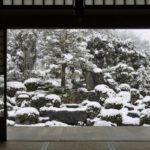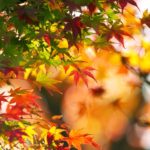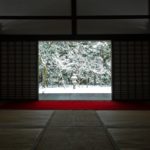The moon is one of the most typical subjects to describe deepening autumn. Seeing the moon in the autumn sky arouses pain and sadness. The technique is not as explicit as in the following Waka.
深まる秋を描くときよく取り上げられるのが、月です。秋の夜空に浮かぶ月を見て、悲しさや苦しみを思い浮かべるのです。次の和歌ほどそれが明確な歌はないのではないでしょうか。
このまより もりくるつきの かげみれば こころづくしの あきはきにけり
konomayori morikuru tsukino kage mireba kokorodukushino akiwa kinikeriThe moonbeams flickering
Through the branches of trees
The herald of pensive fall
I lapse into melancholyLiterally:
When I see moonbeams shining through the branches of trees, I notice that autumn has come, which put me into a pensive mood.
木の陰から漏れてくる月の光を見ると、物憂い気分にさせる秋の訪れを感じるなあ
“Autumn=Melancholy” This equation is not found in earlier anthologies like Manyoshu, the first anthology of Japanese poems, and it was said to be newly brought from ancient China. Poets from the age of Kokinshu put new term in this equation. That is the moon.
「秋=もの悲しい」この公式は「万葉集」以前には見られなかったものです。この考え方は、中国からもたらされたとされています。そして、古今集の歌人たちは、この公式に新たな項を加えました。それが月なのです。






